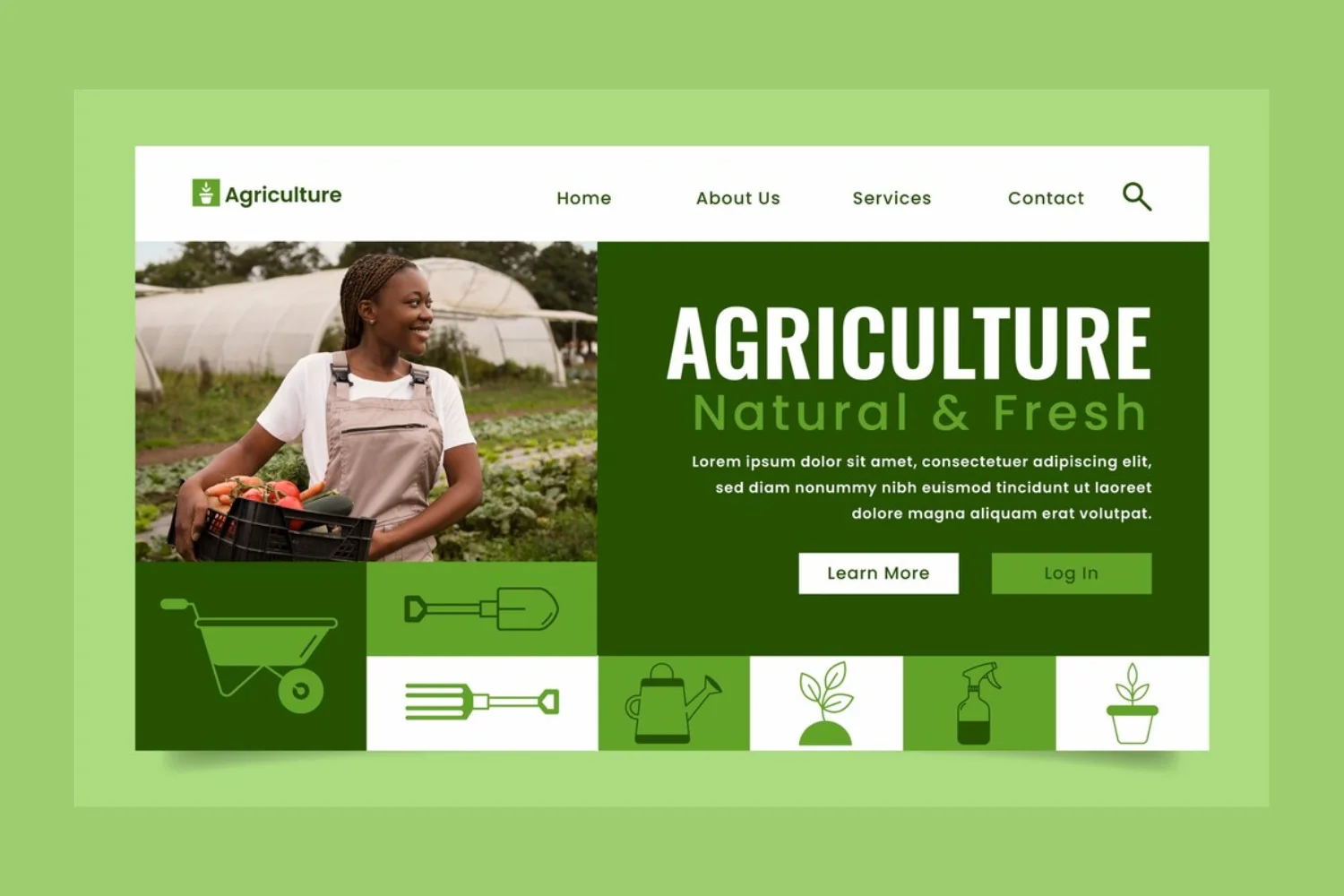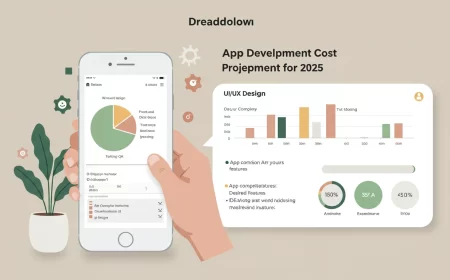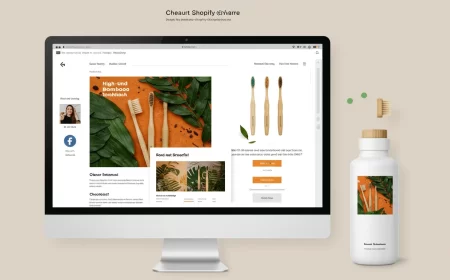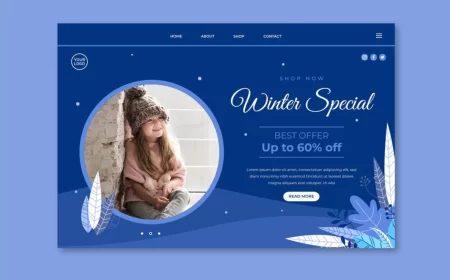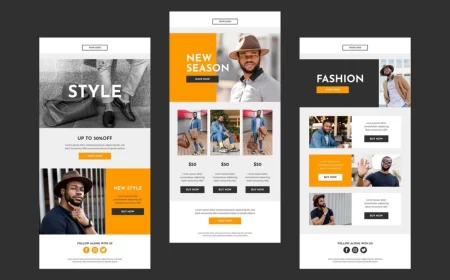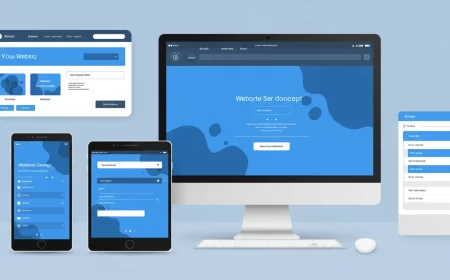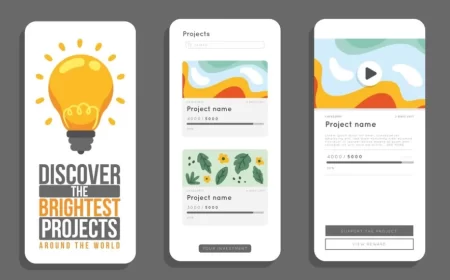Let’s be honest. As a farmer, your to-do list is already a mile long. Between planting, harvesting, animal chores, and bookkeeping, the idea of building a website can feel like just one more chore you don’t have time for. It often feels like a “nice-to-have,” not a “need-to-have.”
But what if your website could be your hardest-working employee? Imagine one that works 24/7, never calls in sick, answers customer questions at 2 AM, and brings new business to your barn door while you sleep. A good website gives your farm a home online, a piece of digital real estate that you own. It’s a place to tell your story, build trust with your community, and make it incredibly easy for people to buy your amazing products. This is about creating your very own digital farm stand, one that’s always open for business.
The good news is you don’t need a complicated, expensive, feature-packed website to make a huge impact. In fact, some of the best farm websites are the simplest. They succeed because they have a clear purpose and they execute it well. This guide will walk you through everything you need to know.
Getting Started: Why Your Farm Needs an Online Home
In the past, a sign at the end of the driveway and a stall at the farmers market were enough. But today, your customers live online. They search for “local organic vegetables” on their phones, look for farm photos on Instagram, and want to order your products from the comfort of their couch. Relying solely on social media is like building your house on rented land. An algorithm can change tomorrow, and your ability to reach your customers could vanish overnight. Your website is your own plot of land where you make the rules.
Having your own site is crucial for several reasons. It builds legitimacy and trust by showing you’re a serious, established business where customers can find reliable information. Your website also acts as your 24/7 salesperson, selling products at any time and automating the process to free you up. Crucially, you own the relationship with your audience. When someone gives you their email address through a subscription form, you have a direct line of communication that isn’t controlled by a social media platform. A website also allows you to tell your whole story, giving you unlimited space to share your history and vision. Finally, it serves as a central hub for all your information, answering common questions so you don’t have to repeat yourself.
Before you write a single word or look at a single design, you need to answer one question. What is the number one thing I want people to do when they visit my website? Everything else, like the design, pages, and photos, flows from this answer. Not all farms are the same, so not all farm websites should be either. The main types include the e-commerce powerhouse using an order form for direct sales, the agritourism magnet with an event registration form to attract visitors, the brand and storytelling hub to build an emotional connection, and the educational resource that might use a feedback form to improve its content. Your site can be a mix, but knowing your primary goal is key.
The Essential Ingredients of a Great Farm Website
Once you know your goal, it’s time to think about the ingredients. While the look and feel can vary wildly, the most effective farm websites all share a few key characteristics.
Your Story: The “About Us” Page That Connects
People don’t just buy food; they buy stories. On your “About Us” page, tell a genuine story about why you started farming. Introduce your family and your team, and don’t be afraid to feature your favorite animals. Using real photos of smiling people builds an instant connection and helps customers feel like they know the people growing their food.
Visuals: Mouth-Watering Photography & Video
You’re in one of the most visually rich industries in the world, so show it off. Investing in good photography is one of the best things you can do for your brand. Your visuals should show the process, from tilling and planting to weeding and harvesting. Feature luscious, close-up shots of your products to make people hungry. Include photos of happy customers and your hardworking team to add a human element.
User Experience: Making it Dirt-Simple to Use
Don’t make your customers think. Your website’s navigation should be crystal clear so that a visitor can understand what you do within five seconds of landing on your homepage. The menu should be simple with logical tabs like Home, About, Shop, and Contact. Ensure your contact information is easy to find and that the text is easy to read with clear headings and short paragraphs.
The Must-Have Pages
At a minimum, your farm website should include a few essential pages. Your Homepage is your digital front door. The About Page is where you tell your story. You’ll need a Products or Services Page to detail what you sell, which might include a custom order form for special requests. A Contact Page should include your address, phone number, email, and a simple contact form. Finally, a Blog or Journal is highly recommended as it’s the engine for keeping your website fresh and engaging your community. If you have a CSA, a clear CSA sign-up form is absolutely essential.
Mobile First: Your Farm in Their Pocket
Well over half of your website visitors will be on a mobile phone, so your website must look good and be easy to use on a small screen. Modern website builders handle this automatically, but you should always test your site on your own phone before you launch it. Make sure you can easily read the text and that the buttons are big enough to tap with a thumb.
Getting Found: A Farmer’s Guide to SEO
Search Engine Optimization, or SEO, is the art of helping search engines like Google understand your website. You don’t need to be an expert, but you should know the basics. Think like a customer and identify the keywords they would use, such as “CSA near me” or “grass-fed beef in [your town].” Use these phrases naturally throughout your website. Registering your farm with Google Business Profile is also key to appearing in local map results.
The Golden Ticket: Building Your Email List
Your email list is your most valuable marketing asset. To encourage sign-ups, offer an incentive like a discount on a first order or a free guide to seasonal recipes. You should make it easy to subscribe by placing a newsletter sign-up form on your homepage, at the end of blog posts, and in your website’s footer. Communicate regularly with a newsletter to build a powerful relationship with your customers.
Bringing Your Website to Life: DIY vs. Hiring a Pro
Okay, so you’re convinced. You know your goals and the key ingredients. Now for the big question, how do you get this thing built? You have two main paths.
The DIY Route: Website Builders
For 90% of farms, a modern website builder is the best option. These platforms are designed for people who aren’t coders and are user-friendly and affordable. Squarespace is fantastic for visual brands like flower farms. For those focused on sales, Shopify is the powerhouse of e-commerce. Wix offers significant creative freedom. Farm-specific platforms like Barn2Door and Local Line also combine e-commerce, CSA management, and marketing tools.
Calling in the Pros: When and How to Hire Help
Sometimes, DIY isn’t the right fit. You might consider hiring a professional if you are not tech-savvy, have a complex business, or simply have the budget and would rather spend your time farming. For those looking for a professional touch, working with an experienced agency can make all the difference. Companies like NeeFox® – Best IT Solutions Company specialize in creating custom web solutions that can handle everything from e-commerce to event booking. If you’ve decided the professional route is right for you, you can get a quote to start the conversation.
The Ultimate Farm Website Inspiration File
Sometimes the best way to get started is to see what others are doing well. Don’t feel you have to copy them. Just browse through and see what you like, what catches your eye, and what makes you want to learn more.
Click on any farm name to visit their website.
CSA & Veggie Farms
- Stoneledge Farm (Leeds, NY): Stoneledge Farm offers a masterclass in clarity. The website immediately presents visitors with everything they need to know about joining their CSA program. There are no frills or distractions, and the design is straightforward and user-friendly. This no-nonsense approach builds trust and makes the sign-up process incredibly simple.
- Abundant Life Farm (Walker, IA): This website excels at creating a personal connection. Their “About Us” section is the core of their brand, warmly introducing their family and farming philosophy. They use genuine, heartfelt language that makes you feel like you know them. This storytelling approach builds a strong sense of community and loyalty.
- Jubilee Organics (Biloxi, MS): The power of this website is in its stunning, vibrant photography. Every page is filled with images of lush fields and colorful produce that makes your mouth water. They effectively sell the beauty and health of their food before you even read a word. This site is a testament to the idea that investing in high-quality visuals is investing in sales.
- Frog Holler Farm (Ann Arbor, MI): This website is a great model for any small farm wanting a professional online presence without a lot of complexity. The design is simple, clean, and incredibly easy to navigate. It proves you can have an effective, trustworthy website on a budget and without overwhelming your customers.
- Norwich Meadows Farm (Norwich, NY): Known for supplying elite NYC restaurants, this farm’s website perfectly reflects its reputation for premium quality. The design is clean and professional. The focus is on their unique varieties and meticulous farming practices, educating the customer on what makes their products superior.
- The Last Organic Outpost (Houston, TX): This website is much more than a place to buy produce, it’s a digital community center. The focus is clearly on their mission of education and community building, with a clear volunteer application form. The site is designed to engage visitors and encourage participation. It’s an excellent example of how a farm’s website can serve a larger social mission.
- Philo Apple Farm (Philo, CA): Philo Apple Farm’s website successfully sells an entire experience, not just a product. Their online presence is built around their farm stays, cooking classes, and the idyllic lifestyle of Anderson Valley. The site uses beautiful, atmospheric photography and elegant design to transport you to the farm.
- Goranson Farm (Dresden, ME): This website does a fantastic job of organizing a diverse family business. As a multi-generational farm with a CSA, farm store, and farmers market presence, they have a lot of information to convey. Their site uses clear, intuitive navigation to guide visitors to the specific information they need.
- Blue House Farm (Pescadero, CA): Blue House Farm’s website is a standout example of strong, consistent branding. From the logo and color scheme to the tone of voice, every element works together. Their online store is robust and user-friendly, making it easy for customers to buy everything from CSA shares to individual bunches of carrots.
- Angel Valley Farm (South Salem, NY): This website is a perfect example of elegant simplicity. It proves that you don’t need dozens of pages or complex features to have an effective online presence. With just a few well-designed pages, beautiful photos, and clear information, they convey a sense of quality and care.
Meat, Poultry & Dairy
- White Oak Pastures (Bluffton, GA): This site is a masterclass in mission-driven marketing. It’s built around their deep commitment to regenerative agriculture and radical transparency. Their massive online store is seamlessly integrated, allowing you to buy the products you’ve just spent time learning about.
- Five Marys Farm (Fort Jones, CA): Five Marys doesn’t just sell meat, they sell an aspirational lifestyle. Through incredible photography, a personal blog, and deep social media integration, they’ve built a powerful brand that feels both authentic and inspiring. They successfully market meat, but also cookbooks, courses, and a “farm life” brand.
- Joyce Farms (Winston-Salem, NC): This is a very professional website that focuses on educating the customer about what makes their product superior. Their “Our Difference” section is a fantastic example of clearly articulating value. The clean design and high-quality product photography reinforce their message of quality and expertise.
- Snake River Farms (Boise, ID): This website is an excellent case study in premium e-commerce. Focusing on American Wagyu beef, the entire site feels like a luxury brand. They demonstrate how to position a farm product as a gourmet, luxury good and command a premium price for it online.
- Primal Pastures (Murrieta, CA): Primal Pastures does a great job of connecting their farming practices directly to their customers’ health goals. The website clearly explains the benefits of pasture-raised meats. They also make the purchasing process incredibly easy by distinguishing between local pickup and national shipping.
- Niman Ranch (Westminster, CO): As a large network of independent family farms, Niman Ranch’s website serves as a powerful branding hub. It focuses on their shared values and high standards for animal welfare. It’s a great example of how multiple producers can unite under a single, powerful online identity.
- Stony Creek Farmstead (Walton, NY): This website perfectly blends two business models, selling farm products and offering farm stays. The design is rustic, warm, and inviting. They use beautiful photography to show families enjoying the farm, making the idea of a visit irresistible.
- Long Winter Farm (Starksboro, VT): This is a perfect model for a small farm just starting out with e-commerce. The website is clean, charming, and effective. The online store is straightforward and easy to manage, demonstrating that a small farm can create a professional online store on a limited budget.
- Cricket Creek Farm (Williamstown, MA): This beautiful website for a small dairy and creamery puts the craft of cheese-making front and center. The photography is excellent, with artistic shots of their cheeses, animals, and landscape. The design is clean and elegant, elevating their product and conveying artisanal quality.
- Tendergrass Farms (Floyd, VA): The strength of this website is its laser focus on the shopping experience. It functions as a very well-organized online marketplace. You can easily shop by the cut of meat, by the type of animal, or by curated boxes. This user-friendly approach removes friction from the buying process.
Flower & Specialty Farms
- Floret Flowers (Mount Vernon, WA): Floret’s website is the undisputed gold standard. It’s a blog, a store for seeds and tools, a registry for their books, and a hub for online workshops. The design is breathtaking, the content is valuable, and every element works in harmony to support a multi-faceted business.
- Field & Florist (Chicago, IL): This website is a perfect example of a chic, modern brand that successfully bridges the gap between a rural farm and an urban market. It seamlessly combines their flower farm with their floral design studio and retail shops. The design is clean, minimalist, and stylish.
- Bear Creek Farm (Stanfordville, NY): This website is a masterclass in visual marketing. Focusing on highly sought-after dahlia bulbs, the site features stunning, magazine-worthy photography that makes each bloom look like a work of art. They understand that for a premium, visual product, the quality of the photography directly translates into sales.
- Sunny Meadows Flower Farm (Columbus, OH): Sunny Meadows has built a website that serves multiple audiences brilliantly. They provide a wealth of educational content and a dedicated wholesale portal for fellow growers. This positions them as leaders and trusted experts in their field.
- Cross Street Flower Farm (Norwell, MA): This website is an excellent case study in using events and workshops to drive business. They prominently feature their “U-Pick” events, on-farm workshops, and popular flower CSA. This strategy turns the website into an interactive hub that gets people physically onto the farm.
- The Farmhouse Flower Farm (Robesonia, PA): This website perfectly captures the charm and personality of a small, family-run business. The design feels personal and handmade, and the language is warm and welcoming. It’s a wonderful model for any small farm that wants to leverage its size as a strength.
- Love ‘n Fresh Flowers (Philadelphia, PA): As a farm that specializes in wedding florals, this website functions as a perfect visual portfolio. It is designed to attract and captivate prospective brides. The style is romantic and sophisticated, perfectly matching the target audience.
- Blue Ridge Blooms (Asheville, NC): This site is another fantastic example of a farm focusing on a niche floral design service. The design is clean, romantic, and airy, immediately setting a specific tone. It shows the power of a clean aesthetic and a clear focus when targeting a specific type of customer.
- Treadlight Farm (Bovina Center, NY): This website is proof that simple and elegant can be incredibly effective. Without complex features, Treadlight Farm uses beautiful photography and a minimalist design to showcase their unique blooms. It looks professional, trustworthy, and sophisticated.
- Eufloria Flowers (Nipomo, CA): As a larger growing operation, Eufloria’s website is tailored perfectly to its wholesale audience. The site is polished, professional, and provides florists with the exact information they need. It’s a great example of how to create a website that functions as an efficient tool for wholesale clients.
Agritourism & U-Pick Farms
- Soule Homestead (Middleborough, MA): As a non-profit educational farm, this website does a great job of communicating its mission. The event calendars are clear and there are prominent calls to action for donations and volunteers. The design feels welcoming and family-friendly, perfectly matching their purpose.
- Underwood Family Farms (Moorpark, CA): This website is the central hub for a massive agritourism operation. It successfully wrangles a huge amount of information, from seasonal festivals to U-pick schedules. For any farm that hosts multiple events, this site is a great case study in keeping a busy schedule clear for the public.
- Bishop’s Pumpkin Farm (Wheatland, CA): This website is all about building excitement for a specific season. The entire site is designed to get visitors excited about the fall experience. The branding is consistent and fun, showing how a farm can become synonymous with a seasonal family tradition.
- Applecrest Farm Orchards (Hampton Falls, NH): This farm has many different parts to its business, and its website balances them all beautifully. Despite the amount of information, the site is well-organized. It’s a great model for a diversified farm that needs to serve many different customer needs.
- Jones Family Farms (Shelton, CT): This farm combines a winery and a Christmas tree farm under one cohesive online roof. The website uses clear top-level navigation to guide visitors to the experience they’re looking for. It’s a smart way to manage multiple distinct businesses on a single domain.
- Saunders Farm (Ottawa, ON, Canada): The design of this website perfectly matches the experience of visiting the farm since it’s fun, playful, and full of energy. They use bright colors and engaging fonts that appeal to families with children. This is a great reminder that a website’s design should reflect the farm’s personality.
- Smolak Farms (North Andover, MA): Smolak Farms’ website does an excellent job of showcasing the sheer variety of activities available. From fruit picking to the bakery, the site acts as a comprehensive guide to a full day of fun. They use lots of photos of families enjoying the farm to communicate the experience.
- Terhune Orchards (Princeton, NJ): This website excels at positioning the farm as a year-round destination. They have clear sections for what’s happening in each season, which encourages repeat visits. This structure helps customers understand that there’s always something new to see or do.
- Hill High Farm (Winchester, VA): This is a fantastic example of themed marketing. The website focuses heavily on their popular “haunting” season in the fall. This targeted approach creates a lot of buzz and excitement for their main event and shows the power of leaning into a specific theme.
- Green Bell Farm (Petaluma, CA): The focus of this website is squarely on their farm stays and educational programs. The site uses beautiful, serene photography that sells a peaceful and immersive experience. It’s a great example of how to market a more intimate, high-value agritourism experience.
All-Around Great Examples
- Polyface Farm (Swoope, VA): While not the most modern design, Polyface’s website is a powerhouse of content. It’s packed with detailed information and resources, positioning them as leading experts. It’s a testament to the idea that the depth of information can be more important than a flashy design.
- Apricot Lane Farms (Moorpark, CA): Famous from the documentary “The Biggest Little Farm,” this website beautifully tells their story of biodynamics. The site is visually stunning and functions as an educational hub. It’s a top-tier example of a farm using its unique story to build a global brand.
- Our Table Cooperative (Sherwood, OR): This website clearly explains a complex business model, a multi-stakeholder cooperative. The site explains their mission, structure, and how people can get involved. It’s a great example of a website built to rally support for a unique vision.
- Gaining Ground (Concord, MA): This is a beautiful website for a non-profit farm that grows food for hunger relief. The primary goals are to share their mission and solicit donations, which the site achieves with grace. It’s a wonderful example of a website used as a powerful tool for fundraising and community building.
- The Ecology Center (San Juan Capistrano, CA): This website positions the organization as more than a farm, it’s a vital educational hub. The design is clean, modern, and well-organized. It successfully brings together their diverse offerings under one cohesive and professional brand identity.
- The Battery Urban Farm (New York, NY): Located in New York City, this website shows what’s possible for urban agriculture. The site uses its web presence to tell the story of how they educate thousands of students. It’s an inspiring example of how a very small farm can have a very large community impact.
- Hawthorne Valley (Ghent, NY): Hawthorne Valley is a diverse organization with a farm, school, and store. Their website does an impressive job of tying all these different threads together. The navigation is clear, allowing visitors to easily explore the different facets of the organization.
- Kona Coffee & Tea (Kona, HI): This is a great example of a website for a specialty crop farm. The site tells the story of their specific product, Kona coffee, and its unique region. This storytelling, combined with a polished e-commerce experience, elevates their product from a commodity to an artisanal experience.
- Congaree and Penn (Jacksonville, FL): This farm also hosts high-end weddings and fine dining events. Their website reflects this with a beautiful, sophisticated design that feels like a luxury brand. The photography is stunning, and the copy is elegant, attracting a clientele looking for a premium experience.
- Black Dirt Farm (Stannard, VT): This farm focuses on a niche product which is high-quality compost. Their website is clean, professional, and highly educational, positioning them as experts. The site provides immense value to their target audience of gardeners and other farmers, building trust and authority.
Your Questions Answered & Final Action Plan
Frequently Asked Questions (FAQ)
How much does a farm website typically cost? The cost can vary dramatically. Using a DIY builder like Squarespace or Shopify can cost between $20 to $50 per month, plus your domain name. Hiring a professional designer or an agency like NeeFox® can range from a few thousand to over $10,000, depending on the complexity of the site.
How long does it take to build a farm website? If you use a template on a DIY builder, you could have a simple site up in a single weekend. A custom-built website by a professional can take anywhere from 4 to 12 weeks or longer, depending on the project’s scope.
Can I sell products directly from my website? Absolutely! This is one of the biggest benefits. To sell products, you’ll need a platform with e-commerce functionality, a way to accept payments like Stripe or PayPal, high-quality photos, clear descriptions, and a plan for shipping or pickup that starts with a clear inquiry form.
I’m not a good writer. How do I create content for my site? Don’t try to be a professional writer. Just be yourself and write like you talk. Tell your story, share your passion, and describe your products honestly. Your customers will appreciate authenticity over perfect prose.
Do I really need a blog? While not strictly necessary, a blog is one of the most powerful tools for your website. It keeps your site updated, which search engines love. It also allows you to share your story, build a deeper connection with customers, and establish you as an expert.
How do I get good photos for my website? Modern smartphones have excellent cameras. The key is good lighting. Take photos in the early morning or late afternoon for soft, beautiful light. Avoid harsh midday sun. Get close to your subjects and focus on capturing the color and texture of your products.
Your Three-Step Action Plan
Feeling inspired? Or maybe a little overwhelmed? That’s normal. The longest journey starts with a single step. You don’t need to build the next Floret Flowers overnight.
Just start here. First, define your number one goal. Before you do anything else, grab a piece of paper and write it down. Second, pick your platform. Based on your goal, choose your path. Don’t overthink it, just start a free trial and play with it. Finally, build your “Minimum Viable Website.” Don’t try to build the whole thing at once. Start with just three pages, a simple Homepage, a basic About Page, and a Contact Page. You can launch with just that.
Your website is a garden. You don’t just plant it and walk away. You plant the seeds, you water it, you weed it, and over time, it grows into something amazing. The most important thing is to get those first seeds in the ground. Good luck!

